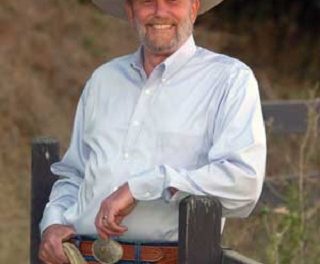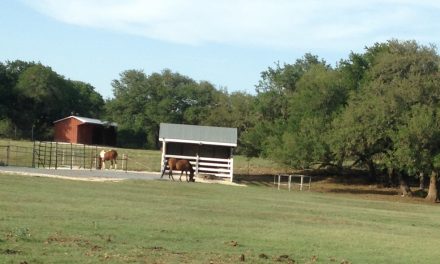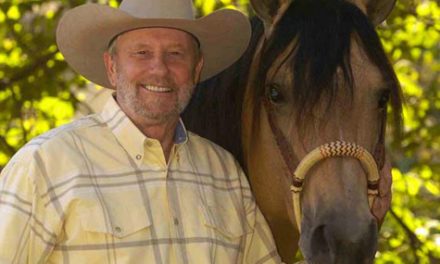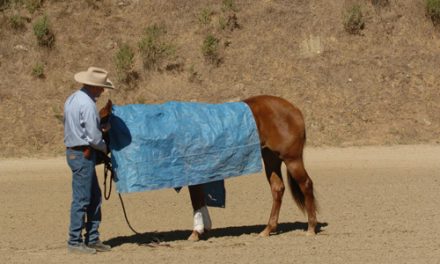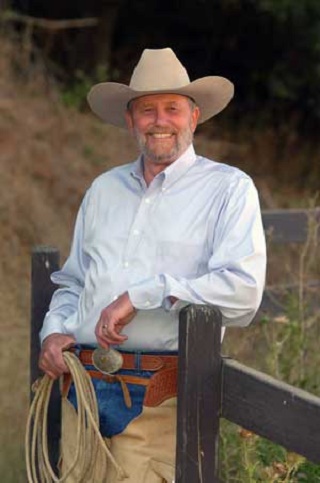
Spurs are a training aid to assist us to get a horse to go in the direction we would like it to go. We are looking for a well trained horse, whether we want the horse to be an eventer, a dressage horse, a reiner or just a good trail horse. You can look at spurs as the training wheels on a bicycle. At first the wheels are on the ground but as the rider becomes more proficient, the wheels are raised and eventually removed. With spurs it is as if we raise the wheels but we don’t remove the spurs. They are there if we need them but we don’t use them unless we have to. Like any other aid, we don’t want to depend on them to train the horse. We suggest what we would like the horse to do with a lighter aid and, if there is no response, we use the spur as follow up. I use spurs on a daily basis because I ride all horses in spurs. They are part of me and I even go to dinner in spurs. They are a way of life for me. However, I don’t use them every time I ask a horse to go forward, do lateral work (moving sideways) or any other movement. I do use them as an aid, a follow through or a motivator. A dressage stick can also be used as an aid to help motivate and I regularly do mix the use of these two aids. I mix the use of a dressage stick and spurs so the horse I am working does not become dependent and respond only to the spurs.
In the beginning, the spur is the last aid I use to motivate a horse. For example, to ask my horse to turn on the haunches, I want him to move his hindquarters around his front end. I bring my leg back to what I call the number three spot (just behind the cinch) and with the calf of my leg, ask the horse to move away from pressure. Every horse is different; some are more sensitive and others duller just because of their nature. A cold-blooded horse, like a draft horse will have a tendency to be less responsive while a thoroughbred will tend to be a lot more sensitive. I press with the calf of my leg and this is what I call a pre-cue. This is the aid that I really want to be able to use to motivate the horse. If the horse doesn’t respond to the pressure and move his hindquarters, I pick up the inside rein, hold the outside rein and ask the horse to move away from the rein pressure. I also cluck to the horse to help put energy into the feet to create movement and then the last aid I would use is the spur.
With the spur, I may just tip it into the horse, just letting him know it is there. Here again, if I have a very responsive horse, a horse that is really sensitive, just tipping the spur in could motivate that horse to move off my leg. If I am working with a cold-blooded horse, or one that has been nagged at or is dull around the sides, I may have to roll the spur up. In other words, after I tip the spur in, with my heel I roll it up. If that doesn’t work, for the sake of communication, I will bump that horse with the spur. I will keep bumping until I get a reaction. The moment I get some movement in the hind end, I stop.
I will do this exercise in the same order each time. I will pause and then put my leg back on the number three spot. If I don’t get a response, I will pick up the inside rein and hold the outside rein, cluck and if there is no movement, tip the spur in, then roll it up. If there is still no response, I will bump with the spur until the hindquarter moves over. After a time, I may be going through this series and the horse will move when I roll the spur or even just tip it in. By repetition, being specific in my request and consistent in the way I ask, pretty soon the horse will move his hindquarters when I put the calf of my leg on and pick up the inside rein.
When does the horse know the lesson? The horse knows the lesson when I mount and I put my leg on the horse to move the hindquarters away and the horse steps away from the pressure without me tipping my spur or following through with any other aid or other device. The same procedure can be followed using a dressage stick instead of a spur. I could tap the hindquarters with my stick to get movement. What I am really trying to do is to get the horse to move his hindquarters over from just the cue of my leg without using either a spur or dressage stick. That is the goal but to reach it, it may take several days or a couple of weeks of repeating this exercise, being specific and consistent. If, every time you get on the horse and you are riding the horse, say five days a week, with consistent practice, the horse may move his hindquarters over with just a light request by the calf of the leg within two weeks. If you are only working two days a week, it may take three or four weeks.
Consistency, persistence and follow through are the keys. Remember, the spur or the training dressage stick are the aids of last resort. If you use a spur every time, you may get results but the horse will start to get spur sour. With continuous poking, a horse will start resisting. It is the same with constant use of a stick instead of using a pre-cue. The horse is going to get dull and not listen. Or, the horse will start resenting the constant tap, tap and start swishing his tail or other negative behavior such as the ears going back. We need to be careful using the aids. You should only use the spur or the stick as the last resort or motivator but when you do use the spur or stick, you need to get a significant response. We are not looking for a pretty movement; we are looking for a quick response. If you use the aid the and horse is lazy and grudging in this response, you are going to end up using the spur every time. My rule is that if have to use the spur or stick, I’m going to make the horse react to it and move quickly. That is follow up to yielding to pressure.


